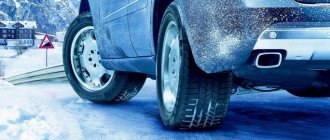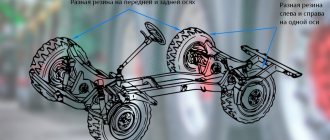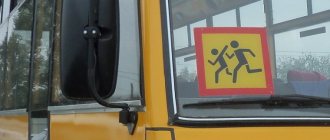Is it possible to drive on summer tires in winter?
No, this is prohibited. Such a ban is regulated by the Technical Regulations of the Customs Union in its paragraph 5.5 in its “requirements for vehicles in operation” (Appendix 8 of the regulations). At the same time, this regulatory act clearly regulates the winter and summer months. The former are December, January and February, the latter are June, July and August.
At the same time, these months may differ if any region of Russia sets its own rules, which is quite logical; and only in the direction of increase, which... is completely illogical. After all, in the same Krasnodar region, winter tires may not be required at all. But alas, such is the law!
5.5. It is prohibited to operate vehicles equipped with tires with anti-skid studs in the summer (June, July, August). It is prohibited to operate vehicles that are not equipped with winter tires that meet the requirements of paragraph 5.6.3 of this appendix during the winter period (December, January, February). Winter tires are installed on all wheels of the vehicle. The terms of the operation ban may be changed upward by regional government bodies of the member states of the Customs Union.
Thus, it is prohibited to drive on summer tires in winter - in December, January and February (dates may vary by region). It is not necessary to change to winter tires from October 1 and November 1.
Where can I find out about increasing the ban in my city?
Unfortunately, there is no way to definitively answer this question. For 2021, not a single region or city has changed the provisions of the Technical Regulations regarding summer tires in winter.
If such changes are made, this may be reflected both in local government regulations and in regional legislative acts. We regularly monitor current legislation, including in the regions, so if innovations appear regarding changing the ban on driving summer tires in the winter months, we will update this article.
You will also be interested in:
- Is there a fine for driving on summer tires in winter and winter tires in summer today? What date will it start?
- How to legally avoid a fine for a “Spikes” sign?
- Is it possible to drive on winter tires in summer and what is the fine?
A spare tire for all seasons
This means that you can absolutely legally drive a summer spare tire to a tire shop or parking lot in winter. The traffic police inspector has no reason to fine you under Article 12.5 of the Administrative Code “Driving a vehicle in the presence of malfunctions or conditions under which the operation of vehicles is prohibited.” And if he still tries to do this, briefly explain to him the content of this material. Then the inspector will definitely let you go in peace.
- It doesn't matter what kind of tires. Anti-slip bracelets will always help you in an unforeseen situation on the road or without it.
- Are you planning a trip out of town? It’s better to have the anti-bux in the trunk at the right time.
What is the fine for driving in winter on summer tires in 2021?
But the time has come for good news for drivers - there is no fine for summer tires in winter. It did not exist, and to date it has not appeared either in the federal Administrative Code or in the regional “Administrative Codes”.
This is quite easy to check. Since the ban on driving summer tires in winter is regulated only by the Technical Regulations, the Code of Administrative Offenses must refer to it when such a fine is provided for. But this Code refers to the first only in one case: for tinting in Part 3.1 of Article 12.5 of the Administrative Code. You will not find other fines for violations of the Technical Regulations in the entire chapter of penalties for traffic violations (Chapter 12 of the Administrative Code).
Thus, there is no fine for summer tires in winter (both in October and November, and directly in the months of direct ban - December, January and February).
As we mentioned earlier, the article will be updated if anything changes on this matter.
But still there is another fine that applies to any: both winter and summer in winter. And what a fine this is!
Penalty for remaining tire tread depth
And here the traffic rules “come into play”, or rather their list of faults under which you cannot drive a car. Despite the absence of a fine directly for driving in winter on summer tires, there is a fine, albeit small - 500 rubles, for the remaining tread depth, and it differs for winter and summer tires.
Item 5.1 of the List of Faults prohibits driving the car if:
5.1. The remaining tire tread depth (in the absence of wear indicators) is no more than:
- for vehicles of categories L - 0.8 mm;
- for vehicles of categories N2, N3, O3, O4 - 1 mm;
- for vehicles of categories M1, N1, O1, O2 - 1.6 mm;
- for vehicles of categories M2, M3 - 2 mm.
The remaining tread depth of winter tires intended for use on icy or snowy road surfaces, marked with a sign in the form of a mountain peak with three peaks and a snowflake inside it, as well as marked with the signs “M+S”, “M&S”, “MS” (if absence of wear indicators), during operation on the specified coating is no more than 4 mm.
As you can see, if your tires do not have wear indicators, then for summer tires of passenger cars and Gazelles and the like, whose maximum weight does not exceed 3.5 tons (categories M1 and N1, respectively), the tread depth must be at least 1.6 mm.
All categories of vehicles listed in the quotation from the traffic rules above:
- L - motorcycles and mopeds,
- M1 - cars and passenger cars with up to 8 seats,
- M2 - passenger cars with more than 8 seats, but with a maximum weight of up to 5 tons,
- M3 - passenger cars with more than 8 seats and a maximum weight of more than 5 tons,
- N1 - cargo trucks with a maximum weight of up to 3.5 (Gazelle, Barguzin and the like),
- N2 - cargo trucks with a maximum weight from 3.5 to 12 tons,
- N3 - cargo vehicles with a maximum weight of more than 12 tons,
- O3 - truck trailers with a maximum weight from 3.5 to 10 tons,
- O4 - truck trailers with a maximum weight of more than 10 tons.
Winter tire markings and tread fines
But all this applies to summer tires. But winter has its own rules. But first, about labeling. It must either have an image of a mountain with three peaks and a snowflake inside, or one of the markings specified in paragraph 5.1, when there are no wear indicators. These markings are shown in the figure below.
And if you have winter tires with exactly this marking, then their tread depth should be at least 4 millimeters. And here is an example to compare a new winter tire with a tire with a tread depth of less than 4 mm:
The fine for non-compliance of the tread depth with the restrictions in the traffic rules is 500 rubles under Part 1 of Article 12.5 of the Administrative Code. The article also provides for the possibility of issuing a written warning for this.
In general, tires marked “M+S”, “M&S”, “MS” almost always have wear indicators, and, at the same time, there will be absolutely no marking with a snowflake, because a snowflake only means winter tires, and the designation with The letters M and S imply all-season, although there are many exceptions to this. Legs grow again from those regulations that allow the use of all-season tires in winter.
History of the issue.
It should be noted that there were reasons for concern - several attempts were made to resolve the issue at the legislative level:
- In 2009, a bill was submitted (No. 180147-5), which provided for a fine of 500 rubles for using summer tires in winter. Reviewed and rejected in 2010.
- In 2014, bill No. 245967-6 was considered and rejected, which proposed a fine of up to 2,000 rubles for driving on summer tires in winter.
Another troublemaker was bill No. 464241-6, also proposed in 2014. The document provides for amendments to Article 12.5 of the Code of the Russian Federation on Administrative Offenses. The purpose of amending (adding part) of the article is to prohibit the use of vehicles that violate the requirements for the operation of wheels and tires. It is planned to apply a fine of 2,000 rubles to drivers as sanctions.
The decision was postponed several times, until November 20, 2016, when the bill was officially sent for consideration to the State Duma. On November 1 of the same year, legislators decided to postpone consideration indefinitely (in fact, the document was not heard in the first reading). The issue was not reviewed again during 2021.
Is it possible to drive an all-season vehicle in winter?
Can. For all-season tires, just like for summer tires, there is no penalty in winter.
But tread depth on all-season tires is a little more complicated. They are almost never marked with a mountain peak with a snowflake, but may often have the inscription "M+S" or similar.
Therefore, it also requires a tread depth of at least 4 mm when driving in winter, if it has at least one of the above symbols. If not, then for passenger cars - at least 1.6 mm.
How to drive on winter tires?
Driving on summer tires in winter requires increased attention. The adhesion of cold asphalt and tires is at extremely low levels during this period. Braking on winter roads needs to be done with a large margin. It is necessary to increase the distance on the roads between vehicles.
It is strictly forbidden to make sharp turns of the steering wheel in winter. This may cause the car to skid. Uncontrolled sliding occurs when the gas is released during the turning arc.
The situation is aggravated by pressing the brake pedal to the floor.
General rules and advice
In cases where for some reason you have to drive a vehicle shod with summer tires in winter, it is not recommended to drive at a speed of more than 60 km/h. When driving on a winter road at night on any type of tires, it is necessary to maintain a speed that provides a braking distance within the section of road illuminated by the vehicle’s headlights.
Common mistakes
Among the most common causes of road accidents in winter:
- failure to maintain a safe distance between vehicles;
- high speed;
- sudden braking;
- lack of winter driving skills.
Many drivers feel bad about their car in extreme winter driving conditions. This leads to their loss of control of the vehicle.
What can help?
You can maintain control of the vehicle by following certain driving rules:
- vehicle acceleration must be performed only on straight wheels;
- Do not suddenly release the gas and turn the steering wheel in a panic;
- Before braking, you must slow down in advance.
Driving on summer tires in winter
The use of summer tires in winter is prohibited by the Technical Regulations, which stipulate the characteristics of winter tires. Also, summer tires turn operating a car in icy conditions into a complex process that only stuntmen can do. At subzero temperatures, the hardness of the rubber mixture increases, the grip weakens, and the car stops obeying the steering wheel. You can conduct an experiment by leaving a regular school eraser in the cold. The soft texture will lose its elasticity when exposed to cold, and the eraser will break without effort. Summer tires behave the same way on snowy roads at sub-zero temperatures. The braking distance of the car increases, which leads to dangerous situations on the road, and the service life of the tires is significantly reduced. The requirements for tires in winter, specified in the Technical Regulations, allow you to choose the best option that will ensure road safety.
We recommend: What to do if the engine oil foams?
At temperatures around zero, the summer model is relatively safe on dry asphalt, a non-aggressive driving style and moderate traffic conditions. All these conditions rarely coincide, so the car when it’s above +5 degrees outside. Operating a car with summer tires at 0 degrees is complicated by ice, areas with wet snow, and congested roads. When braking sharply, even at a speed of 40 km/h, the anti-lock braking system is activated, which indicates the difficulty of stopping.
Eventually:
- Summer tires are not able to provide sufficient grip at temperatures below 7 degrees Celsius due to fewer plates and increased rubber hardness.
- The channels of summer tires are not able to remove more snow and slush. They can only handle water.
- In winter, summer tires can burst.
And which all-season tires did we mention as a cheaper alternative to winter tires? These are winter tires adapted for summer driving. They provide good conditions for winter driving and a little worse in summer. In addition, spring and summer wear is slightly faster than standard summer tires. In turn, the driver should not be afraid of winter conditions and can count on significant savings.
Of course, an all-season tire does not relieve the driver of the need to balance the wheels annually (and preferably every six months).
Finally, the results of a study conducted by Uniroyal. This involved a car traveling at 50 km/h in winter conditions that suddenly had to brake.
What was the braking distance?
- With winter tires on wheels - 31 meters;
- With all-season tires on wheels - 42 meters;
- With summer tires on wheels - 62 meters.
While the difference in braking distance between winter and all-season tires can be compensated for by more careful driving, the same cannot be done with summer tires. What can ultimately double the braking distance? It's not hard to imagine.
For curiosity's sake, let's add information that another type of tire has appeared on the market. These are summer tires with winter approval. This is in contrast to all-season tires, which are winter tires with summer approval. As always, with new products you should approach them with extreme caution. Because new products are not always good.
How do the new amendments benefit drivers?
Simultaneously with these amendments to the law, another document came into force: the Regulation “On the Safety of Wheeled Vehicles”. According to the requirements of this regulatory legal act, driving in winter on summer tires is prohibited (meaning the period from December to March). In addition, this legislative act contains the requirement that driving in the summer on winter tires is also prohibited.
The document contains a rule according to which local authorities can change the periods established by this legislative act when winter time begins and ends in certain regions. You can drive on summer tires during other periods established by regional legislation, taking into account the peculiarities in different parts of the country.
The basic provisions on the approval of a product for use do not contain a direct ban on driving on summer tires.
Therefore, issuing a fine for such a violation is illegal.
Is it possible to drive in winter on summer tires? Traffic police officers say that a fine can only be issued for bald tires, and it does not matter what season it is intended for. Despite the fact that inspectors pay attention to the seasonality of tires on a car, they are limited to only warning.











